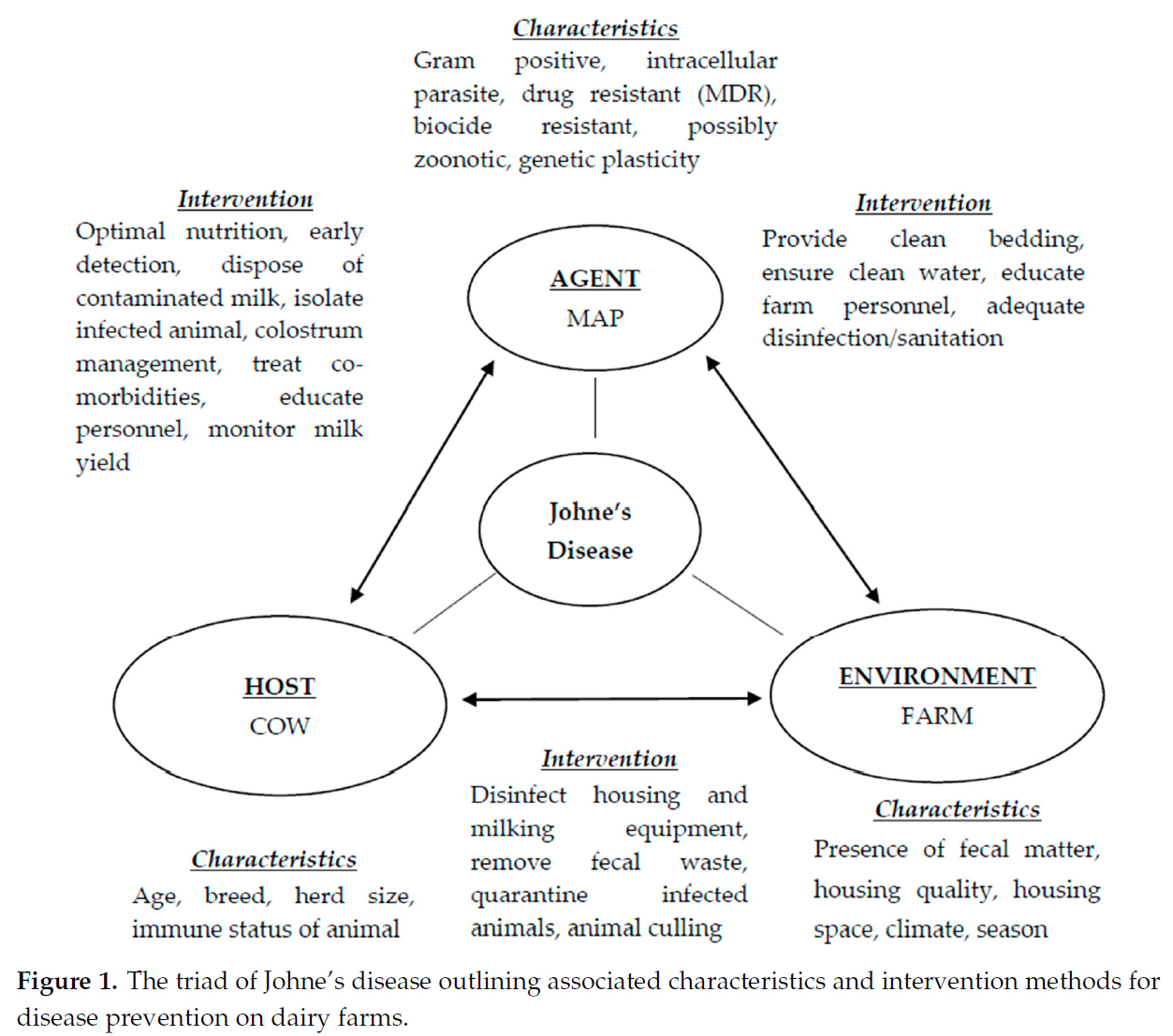Mary Garvey, Lecturer at the Institute of Technology Sligo, Sligo, Ireland published a review article titled: Mycobacterium Avium Paratuberculosis: A Disease Burden on the Dairy Industry in the journal Animals (11 pages with 58 references).

Abstract
Mycobacterium avium paratuberculosis is responsible for paratuberculosis or Johne’s disease in cows, having economic impacts on the dairy industry and a prevalence rate exceeding 50% in dairy herds. The economic burden of Johne’s disease relates to decreased milk production and costs of disease prevention, treatment, and management, while having an economic impact on dairy producers, processors, consumers, and stakeholders of the dairy industry. Determining the true economic impact of the disease is difficult at regional and farm level as symptoms are not evident in subclinically infected animals. At present, the virulence, pathogenicity, persistence, and infectious dose of M. avium paratuberculosis are poorly understood, consequently effective paratuberculosis control measures remain obscure. M. avium paratuberculosis is potentially zoonotic with foodborne transmission a public health risk due to a possible causative link with inflammatory bowel disease in humans. A preventive approach is necessary to reduce the presence of this drug-resistant pathogen in dairy herds and subsequently dairy food. The use of inefficient diagnostic tests coupled with the long latency period of infection results in delayed animal culling and trade of asymptomatic animals, leading to regional transmission and increased disease prevalence. To date, there has been limited success at controlling and treating this terminal endemic disease, leading to significant prevalence rates. This study aims to outline the key factors associated with Johne’s disease while outlining its significant impact on the dairy sector.
Comment: The direct financial costs of Johne’s disease (JD) to dairy producers is small relative to diseases such as mastitis. Hence, without financial incentives most dairy producers conclude that the cost of JD control exceeds the cost of the disease. Therefore, few producers implement JD control programs allowing this chronic, infectious disease to continue spreading within and among dairy herds globally. For more on the epidemiology of JD in dairy cattle read this page of our site.
If, however, MAP is recognized as a zoonotic, food-borne pathogen, causing Crohn’s disease and triggering other so-called autoimmune disease like Type I Diabetes Mellitus, the impact on the dairy industry would be huge.
For more on the MAP as a zoonotic pathogen see this page of our website or for patients, visit the Human Para Foundation website.
Related News
Today, October 15, is the publication anniversary of the landmark paper defining Crohn’s disease (1932). As I do annually, I acknowledge this event in Johnes.org news.
 Eighty-eight years ago, Burrill B. Crohn, Leon Ginzburg, and Gordon D. Oppenheimer published a paper titled Regional Ileitis – A Pathologic and Clinical Entity in the Journal of the American Medical Association (vol. 99, no. 16, pp 1323-1329, October 15, 1932). Honoring the importance of this report, the article was later reprinted as a Landmark Article in The Mount Sinai Journal of Medicine (vol 67, no. 3, pp 263-268, May 2006). We provide the original JAMA article here for users interested in reading this influential publication in its original form. Note: the reprinted version in the Mount Sinai Journal of Medicine has better print quality.
Eighty-eight years ago, Burrill B. Crohn, Leon Ginzburg, and Gordon D. Oppenheimer published a paper titled Regional Ileitis – A Pathologic and Clinical Entity in the Journal of the American Medical Association (vol. 99, no. 16, pp 1323-1329, October 15, 1932). Honoring the importance of this report, the article was later reprinted as a Landmark Article in The Mount Sinai Journal of Medicine (vol 67, no. 3, pp 263-268, May 2006). We provide the original JAMA article here for users interested in reading this influential publication in its original form. Note: the reprinted version in the Mount Sinai Journal of Medicine has better print quality.
Comment: I appreciate history as I grow older. Also, it is important to read original published reports to avoid misquoting or perpetuating misunderstandings. Interesting note: As described in Wikipedia, Crohn always preferred the medically descriptive terms “regional ileitis” and “regional enteritis” to “Crohn’s disease”, but he was not able to prevent the appropriation of his name for the disease. It’s worth noting that Johne’s disease is also a regional ileitis affecting ruminants.
Without providing much detail, B.B. Crohn’s article mentions efforts to determine if Mycobacterium tuberculosis was involved in the regional ileitis cases he described including culture for M. tuberculosis, inoculation of lymph node homogenates from five patients into guinea pigs, rabbits, and chickens, and acid-fast staining of tissue sections. He concludes that M. tuberculosis was not a cause of these cases of regional ileitis. However, he never mentions the 1913 report by Dalziel or makes any mention of Mycobacterium paratuberculosis or the similarities of regional ileitis in humans to that of cattle, as described by H.A. Johne in 1895. Clearly, Dr. Crohn recognized how the pathology in his afflicted patients resembled that caused by a mycobacterial infection. How might history be different had Dr. Crohn considered the possibility M. a. paratuberculosis (MAP) was the cause?
The picture of B.B. Crohn is credited to Wikipedia.